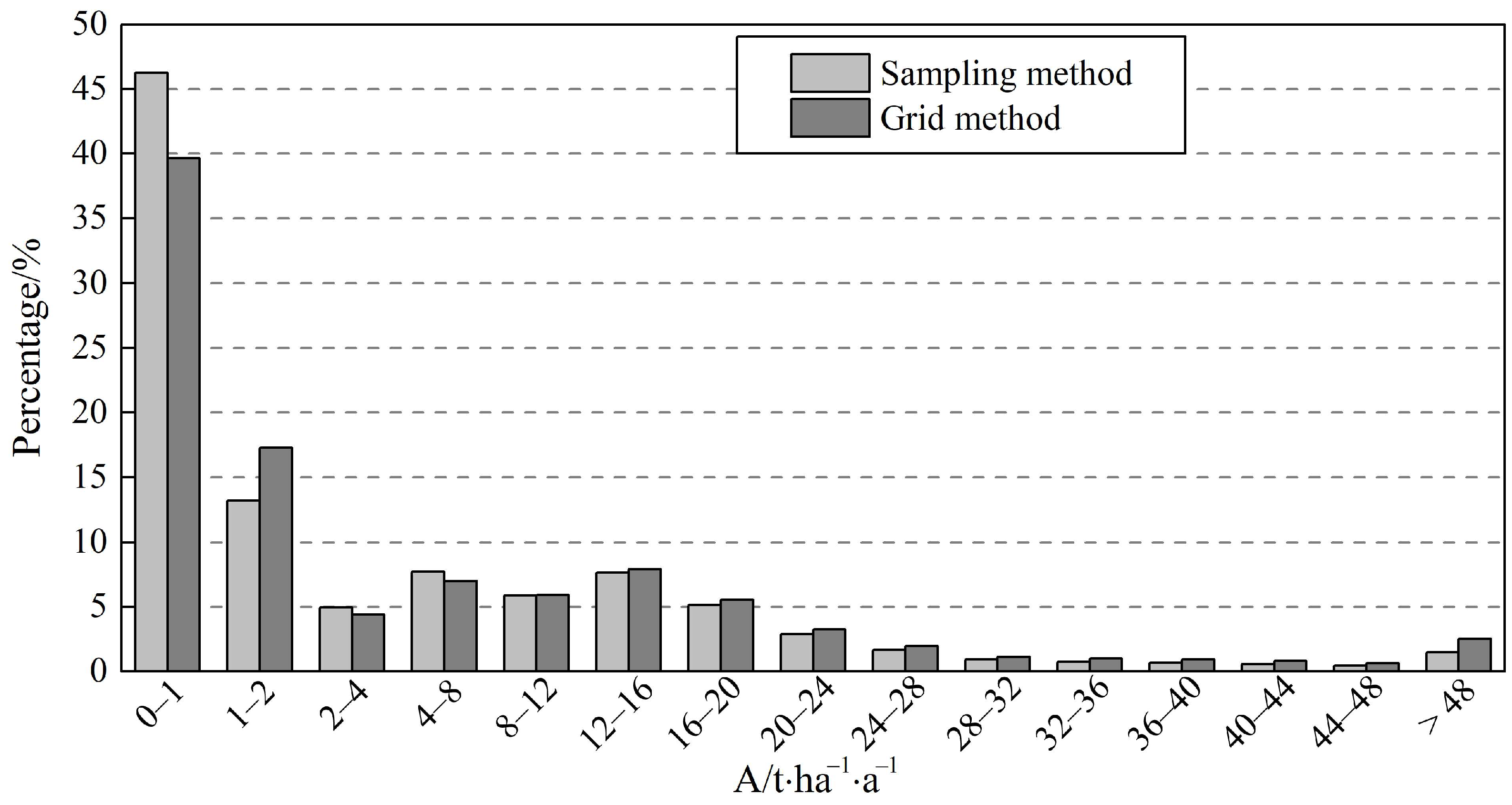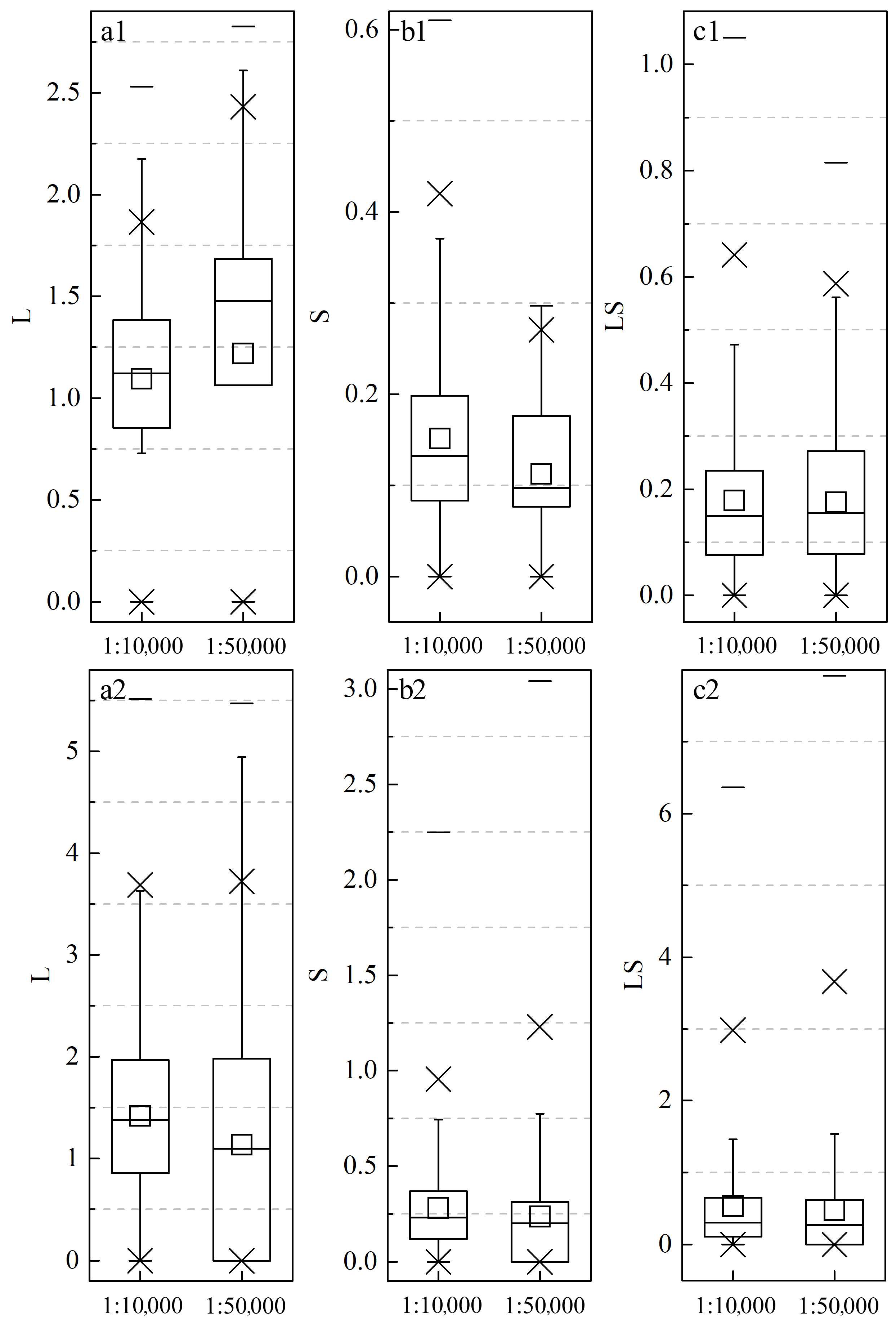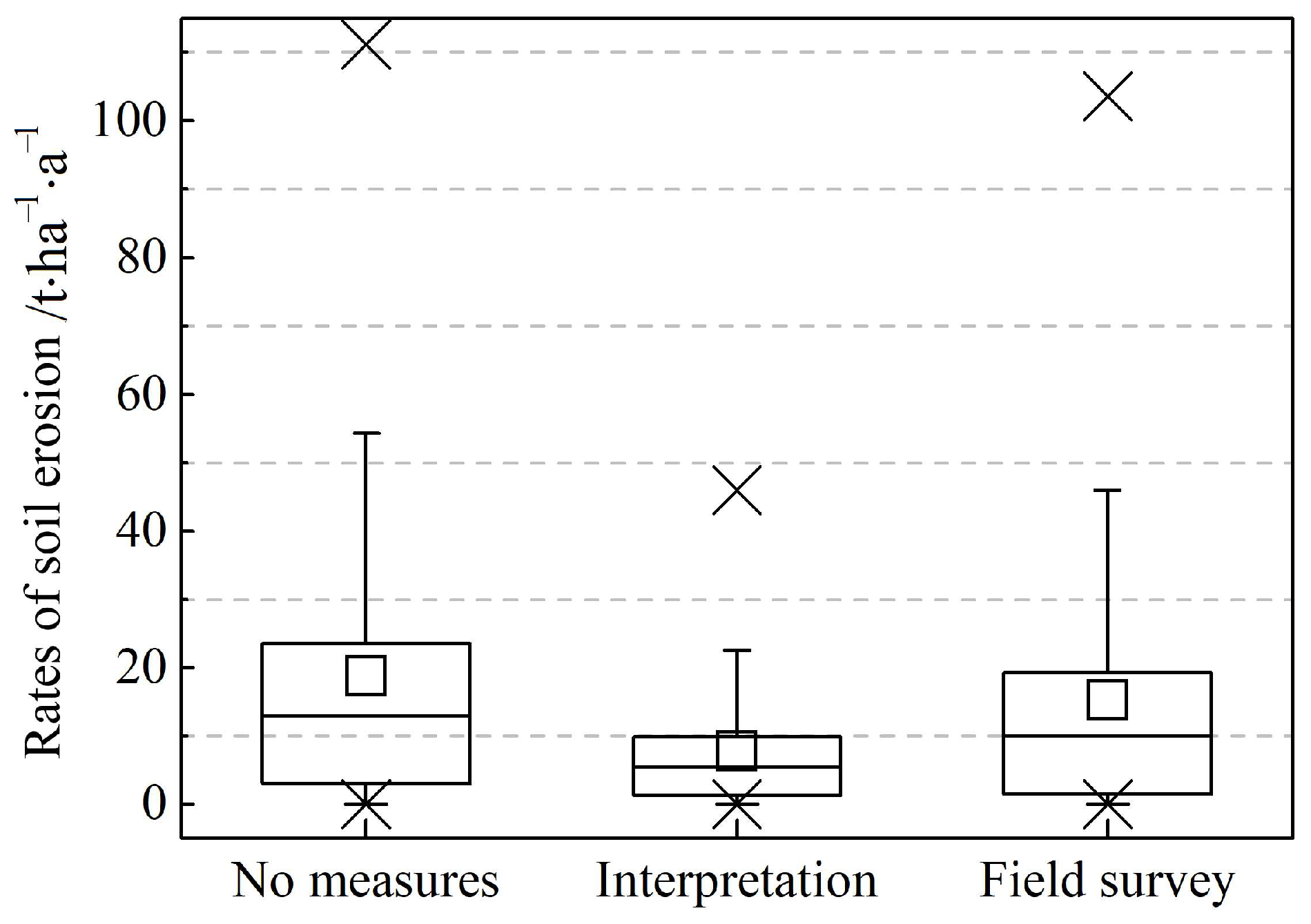Comparison of Sampling and Grid Methods for Regional Soil Erosion Assessment
Abstract
:1. Introduction
2. Material and Methods
2.1. Study Region
2.2. Grid Method
2.2.1. Rainfall Erosivity Factor, R
2.2.2. Soil Erodibility Factor, K
2.2.3. Slope Length and Steepness Factor, LS
2.2.4. Vegetation and Biological Practice Factor, B
2.2.5. Engineering Practice Factor (E) and Tillage Practice Factor (T)
2.3. Sampling Method
2.3.1. Design of Sampling Units
2.3.2. Field Survey
2.3.3. Soil Erosion Rate of Sampling Units
2.4. Other Data Collection
2.4.1. Land-Use Data
2.4.2. Remote-Sensing Image Products
3. Results
3.1. Comparison of the Rates of Soil Erosion
3.2. Comparison of the Rates of Soil Erosion of Different Land-Use Types
3.3. Comparison of Spatial Patterns between Grid Method and Sampling Method
4. Discussion
4.1. Influence of Topographic Data on the Calculation of Rates of Soil Erosion
4.2. Influence of Soil and Water Conservation Measures on the Calculation of Rates of Soil Erosion
5. Conclusions
Author Contributions
Funding
Data Availability Statement
Conflicts of Interest
References
- Liu, Z. Objectives and tasks of soil and water conservation in China. Sci. Soil Water Conserv. 2003, 260, 121109. [Google Scholar]
- Pimentel, D. Soil erosion: A food and environmental threat. Environ. Dev. Sustain. 2006, 8, 119–137. [Google Scholar] [CrossRef]
- Smith, P.; House, J.I.; Bustamante, M.; Sobocká, J.; Harper, R.; Pan, G.; West, P.C.; Clark, J.M.; Adhya, T.; Rumpel, C.; et al. Global change pressures on soils from land use and management. Glob. Chang. Biol. 2016, 22, 1008–1028. [Google Scholar] [CrossRef] [PubMed]
- Liu, B.Y.; Yang, Y.; Lu, S.J. Discriminations on common soil erosion terms and their implications for soil and water conservation. Sci. Soil Water Conserv. 2018, 16, 9–16. [Google Scholar]
- Borrelli, P.; Alewell, C.; Alvarez, P.; Anache, J.A.A.; Baartman, J.; Ballabio, C.; Bezak, N.; Biddoccu, M.; Cerdà, A.; Chalise, D.; et al. Soil erosion modelling: A global review and statistical analysis. Sci. Total Environ. 2021, 780, 146494. [Google Scholar] [CrossRef]
- Dou, X.; Ma, X.; Zhao, C.; Li, J.; Yan, Y.; Zhu, J. Risk assessment of soil erosion in Central Asia under global warming. Catena 2022, 212, 106056. [Google Scholar] [CrossRef]
- Rosewell, C.J. Potential Sources of Sediments and Nutrients: Sheet and Rill Erosion and Phosphorus Sources; Environment Australia: Canberra, Australia, 1997. [Google Scholar]
- Lu, H.; Gallant, J.; Prosser, I.P.; Moran, C.; Priestley, G. Prediction of sheet and rill erosion over the Australian continent, incorporating monthly soil loss distribution. In Land and Water Technical Report; CSIRO: Canberra, Australia, 2001. [Google Scholar]
- Grimm, M.; Jones, R.; Montanarella, L. Soil Erosion Risk in Europe; Joint Research Centre European Commission: Sint Maartensvlotbrug, The Netherlands, 2001. [Google Scholar]
- Panagos, P.; Ballabio, C.; Himics, M.; Scarpa, S.; Matthews, F.; Bogonos, M.; Poesen, J.; Borrelli, P. Projections of soil loss by water erosion in Europe by 2050. Environ. Sci. Policy 2021, 124, 380–392. [Google Scholar] [CrossRef]
- Nusser, S.M.; Goebel, J.J. The National Resources Inventory: A long-term multi-resource monitoring programme. Environ. Ecol. Stat. 1997, 4, 181–204. [Google Scholar] [CrossRef]
- Goebel, J.J. The National Resources Inventory and its role in US agriculture. Int. Stat. Inst. 1998, 181–192. [Google Scholar]
- Harlow, J.T. History of Natural Resources Conservation Service National Resources Inventories; USDA: Washington, DC, USA, 1994.
- Guo, S.Y.; Li, Z.G. Development and achievements of soil and water conservation monitoring in China. Sci. Soil Water Conserv. 2009, 7, 19–24. [Google Scholar]
- Liu, B.; Xie, Y.; Li, Z.; Liang, Y.; Zhang, W.; Fu, S.; Yin, S.; Wei, X.; Zhang, K.; Wang, Z.; et al. The assessment of soil loss by water erosion in China. Int. Soil Water Conserv. Res. 2020, 8, 430–439. [Google Scholar] [CrossRef]
- Fiener, P.; Auerswald, K. Comment on ”The new assessment of soil loss by water erosion in Europe” by Panagos et al. (Environmental Science & Policy 54 (2015) 438-447). Environ Sci. Policy 2016, 57, 140–142. [Google Scholar]
- Panagos, P.; Meusburger, K.; Ballabio, C.; Borrelli, P.; Alewell, C. Soil erodibility in Europe: A high-resolution dataset based on LUCAS. Sci. Total Environ. 2014, 479, 189–200. [Google Scholar] [CrossRef] [PubMed]
- Panagos, P.; Borrelli, P.; Poesen, J.; Ballabio, C.; Lugato, E.; Meusburger, K.; Montanarella, L.; Alewell, C. The new assessment of soil loss by water erosion in Europe. Environ. Sci. Policy 2015, 54, 438–447. [Google Scholar] [CrossRef]
- Yin, S.; Zhu, Z.; Wang, L.; Liu, B.; Xie, Y.; Wang, G.; Li, Y. Regional soil erosion assessment based on a sample survey and geostatistics. Hydrol. Earth Syst. Sci. 2018, 22, 1695–1712. [Google Scholar] [CrossRef]
- Zou, C.R.; Qi, F.; Zhang, Q.H.; Liu, X.; Zhang, R.; Li, J.; Dong, S.; Yao, X. Comparison of different sampling densities and extrapolation methods based on CSLE model. Sci. Soil Water Conserv. 2016, 14, 130–138. [Google Scholar]
- Zhang, H.; Zhang, R.; Qi, F.; Liu, X.; Niu, Y.; Fan, Z.; Zhang, Q.; Li, J.; Yuan, L.; Song, Y.; et al. The CSLE model based soil erosion prediction: Comparisons of sampling density and extrapolation method at the county level. Catena 2018, 165, 465–472. [Google Scholar] [CrossRef]
- Pandey, A.; Gautam, A.K.; Chowdary, V.M.; Jha, C.S.; Cerdà, A. Uncertainty assessment in soil erosion modelling using RUSLE, multisource and multiresolution DEMs. J. Indian Soc. Remote Sens. 2021, 49, 1689–1707. [Google Scholar] [CrossRef]
- Zhang, Y.; Wu, Y.; Liu, B.; Zheng, Q.; Yin, J. Characteristics and factors controlling the development of ephemeral gullies in cultivated catchments of black soil region, Northeast China. Soil Tillage Res. 2007, 96, 28–41. [Google Scholar] [CrossRef]
- Fang, H.; Sun, L.; Qi, D.; Cai, Q. Using 137Cs technique to quantify soil erosion and deposition rates in an agricultural catchment in the black soil region, Northeast China. Geomorphology 2012, 170, 142–150. [Google Scholar] [CrossRef]
- Zhang, Q.W.; Li, Y. Effectiveness assessment of soil conservation measures in reducing soil erosion in Baiquan County of Northeastern China by using 137Cs techniques. Environ. Sci. Process. Impacts 2014, 16, 1480. [Google Scholar] [CrossRef] [PubMed]
- Fang, H.Y.; Sun, L.Y. Modelling soil erosion and its response to the soil conservation measures in the black soil catchment, Northeastern China. Soil Tillage Res. 2017, 165, 23–33. [Google Scholar]
- Fang, H.; Fan, Z. Assessment of Soil Erosion at Multiple Spatial Scales Following Land Use Changes in 1980–2017 in the Black Soil Region, (NE) China. Int. J. Environ. Res. Public Health 2020, 17, 7378. [Google Scholar] [CrossRef]
- Gu, Z.J.; Xie, Y.; Li, A.; Liu, G.; Shi, Y.D. Assessment of soil erosion in rolling hilly region of Northeast China using Chinese Soil Loss Equation (CSLE) model. Trans. Chin. Soc. Agric. Eng. 2020, 36, 49–56. [Google Scholar]
- Zhang, R.; Liu, X.; Heathman, G.C.; Yao, X.; Hu, X.; Zhang, G. Assessment of soil erosion sensitivity and analysis of sensitivity factors in the Tongbai–Dabie mountainous area of China. Catena 2012, 101, 92–98. [Google Scholar] [CrossRef]
- Wischmeier, W.H.; Mannering, J.V. Relation of soil properties to its erodibility. Soil Sci. Soc. Am. J. 1969, 33, 131–137. [Google Scholar] [CrossRef]
- Sharpley, A.N.; Williams, J.R.; Jones, C.A. Erosion Productivity Impact Calculator EPIC: Model Documentation; USDA Technical Bulletin 1768; The Royal Society Publishing: London, UK, 1990. [Google Scholar]
- Foster, G.R.; Wischmeier, W. Evaluating irregular slopes for soil loss prediction. Trans. ASAE 1974, 17, 305–309. [Google Scholar] [CrossRef]
- McCool, D.K.; Brown, L.C.; Foster, G.R.; Mutchler, C.K.; Meyer, L.D. Revised Slope Steepness Factor for the Universal Soil Loss Equation. Trans. ASAE 1987, 30, 1387–1396. [Google Scholar] [CrossRef]
- Liu, B.Y.; Nearing, M.A.; Risse, L.M. Slope gradient effects on soil loss for steep slopes. Trans. ASAE 1994, 37, 1835–1840. [Google Scholar] [CrossRef]
- Ministry of Water Resources of the People’s Republic of China. Techniques Standard for Comprehensive Control of Soil Erosion: SL446-2009; China Water Resources and Hydropower Press: Beijing, China, 2009. (In Chinese) [Google Scholar]
- Wang, B.; Zheng, F.L.; Guan, Y.H. Improved USLE-K factor prediction: A case study on water erosion areas in China. Int. Soil Water Conserv. Res. 2016, 4, 168–176. [Google Scholar] [CrossRef]
- Li, A.; Zhang, X.J.; Liu, B.Y. Effects of DEM resolutions on soil erosion prediction using Chinese Soil Loss Equation. Geomorphology 2021, 384, 107706. [Google Scholar] [CrossRef]
- Gao, Y.; Lv, N.; Xue, C.S.; Ma, H.C. Influence of digital elevation model with different scales to the graded intensity of soil erosion. Soil Water Conserv. China 2007, 10, 26–28. [Google Scholar]
- Yang, Q.K.; Li, R.; Liang, W. Cartographic analysis on terrain factors for regional soil erosion modeling. Res. Soil Water Conserv. 2006, 13, 56–58. [Google Scholar]
- Sun, L.; Zhang, B.; Yin, Z.; Guo, H.; Siddique, K.H.; Wu, S.; Yang, J. Assessing the performance of conservation measures for controlling slope runoff and erosion using field scouring experiments. Agric. Water Manag. 2022, 259, 107212. [Google Scholar] [CrossRef]







| First Class Classification of Land Use | Second Class Classification of Land Use | B Value | Notes |
|---|---|---|---|
| Cultivated land | Paddy field | 1 | Water conservation benefits reflected by T factor |
| Dry land | 1 | Water conservation benefits reflected by T factor | |
| Irrigable land | 1 | Water conservation benefits reflected by T factor | |
| Settlements and mining sites | Urban settlements | 0.01 | Equivalent to 80% vegetation cover |
| Rural settlements | 0.025 | Equivalent to 60% vegetation cover | |
| Independent industrial land | 1 | Equivalent to no vegetation cover | |
| Transportation land | Rural road | 1 | Equivalent to no vegetation cover |
| Other transportation land | 0.01 | Equivalent to 80% vegetation cover | |
| Water area and water conservancy facility land | 0 | The amount of erosion is 0 | |
| Other land | 0 | Bare land is 1, otherwise it is 0 |
| Second Class Classification | Engineering Practices | E Value |
|---|---|---|
| Terrace | Horizontal terraces with soil ridges | 0.084 |
| Horizontal terraces with rock ridges | 0.121 | |
| Sloping terraces | 0.414 | |
| Terraced fields with slope | 0.347 | |
| Field bund | 0.347 | |
| Level steps | 0.151 |
| Grade | Slight | Mild | Moderate | Intense | Extremely Intense | Severe |
|---|---|---|---|---|---|---|
| Rates of soil erosion (t·ha−1·a−1) | ≤2 | 2~12 | 12~24 | 24~36 | 36~48 | >48 |
Disclaimer/Publisher’s Note: The statements, opinions and data contained in all publications are solely those of the individual author(s) and contributor(s) and not of MDPI and/or the editor(s). MDPI and/or the editor(s) disclaim responsibility for any injury to people or property resulting from any ideas, methods, instructions or products referred to in the content. |
© 2023 by the authors. Licensee MDPI, Basel, Switzerland. This article is an open access article distributed under the terms and conditions of the Creative Commons Attribution (CC BY) license (https://creativecommons.org/licenses/by/4.0/).
Share and Cite
Gu, Z.; Cao, S.; Li, A.; Yi, Q.; Li, S.; Li, P. Comparison of Sampling and Grid Methods for Regional Soil Erosion Assessment. Land 2023, 12, 1703. https://doi.org/10.3390/land12091703
Gu Z, Cao S, Li A, Yi Q, Li S, Li P. Comparison of Sampling and Grid Methods for Regional Soil Erosion Assessment. Land. 2023; 12(9):1703. https://doi.org/10.3390/land12091703
Chicago/Turabian StyleGu, Zhijia, Shaomin Cao, Ao Li, Qiang Yi, Shuang Li, and Panying Li. 2023. "Comparison of Sampling and Grid Methods for Regional Soil Erosion Assessment" Land 12, no. 9: 1703. https://doi.org/10.3390/land12091703






